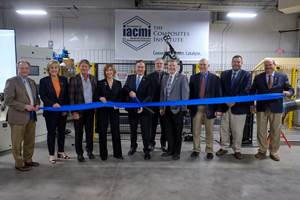Advanced composites — An idealized future
A CW columnist, a composites industry consultant and the chief commercialization officer for the Institute for Advanced Composites Manufacturing Innovation (Knoxville, TN, US), Dale Brosius imagines an ideal future for our industry then challenges us to make it real.
Although we’re still awaiting the mass production of flying cars and miniature fusion reactors, some predictions in the 1985 film Back to the Future for 2015 have, indeed, come true. Among them are in-home videoconferencing and voice and fingerprint recognition for personal devices.
On the 30th anniversary of the movie, the US Defense Advanced Research Projects Agency (DARPA) issued some predictions about the world in 2045. Some of them seem pretty far-fetched (click here for a look), but given the pace of technological development, they might be realized much sooner. So, what would an idealized future for the advanced composites industry look like? And rather than looking out 30 years, how about the next 10 to 20? Here are some of my thoughts:
“Make it and break it” is a thing of the past. Today’s “building block” approach to composites, from coupon level to full structures, is both time-consuming and expensive. As computing power evolves, the necessity to fabricate and test thousands of coupons to derive design allowables goes away. Instead, we manufacture a modest set of critical panels and measure a handful of mechanical properties, and use proven and reliable mathematical models to accurately predict the remaining design properties, called “virtual allowables.” Most important, we believe in them. From these, we are able to predict behavior of as-manufactured components and assemblies in impact, crash, fatigue and other potential failure modes, leading us to design parts at minimum weight and cost. We also characterize the rheology of the various polymers in composites, as well as forming behavior of fibers and textile forms to confidently simulate composite manufacturing processes.
Nondestructive evaluation (NDE) is no longer about “pass/fail.” In fact, NDE is only about making sure things are made correctly, so we no longer wait to sort out the good parts from the bad after all costs have been incurred. We’ve moved diagnostics further upstream into all the manufacturing processes that can impact final part quality, including base fiber and resin production. NDE now provides immediate, automated validation of ply sequences and fiber orientations during part layup or forming, as well as state of cure, resin flow, fiber wash and other parameters during the molding or curing stages. Validated, end-to-end simulation tools take information gathered by a variety of sensors and actually control manufacturing processes, predicting when a process is headed out of specification and then making automated, intelligent decisions: This might lead the machine to increase or reduce mold temperature or resin flow-rate setpoints upon sensing that a particular batch of resin is more or less reactive than the previous one. And this occurs without human intervention.
Efforts to minimize energy use, cycle time and process cost bear fruit. The manufacture of advanced composites structures, previously energy intensive, particularly for carbon fiber, which had very high embodied energy in solution spinning and oxidation of PAN polymers, is no longer. The vision’s a bit hazy here: Perhaps these are still PAN variants, or maybe they are modified polyolefins, or other polymers altogether, including bio-based. But we’ve designed precursor molecules that yield the strength and stiffness needed, yet can be melt spun and oxidized/carbonized at much greater energy efficiency. Thermoset curing and thermoplastic crystallization times have come down, enabling less than one-minute part cycle times with continuous fiber orientations. An increasing number of production parts are 3D printed, and this process has found wide use in the manufacture of rate tooling for all molding processes. In addition to polymer-based tooling, large-area additive manufacturing of metals and metal-matrix composites enables rapid, low-cost fabrication of high-temperature, high-strength molds.
Nearly 100% use and re-use of materials. Watching high levels of cutting scrap go into landfills is a thing of the past. “Buy/fly” ratios (applicable to aircraft structures, and per some colleagues, wind turbines) and “buy/drive” ratios (now a real term for vehicles) for materials procurement have moved close to 1:1, from historical 1.5:1 and higher levels. Large structures in aircraft have closed the gap via automated tape laying and fiber placement, and multiple technologies have done the same for parts with complex geometries, such as those in the auto industry. What in-plant offal we do generate (we no longer produce scrap parts — see NDE above) is immediately recycled into value-added components, perhaps as molding compounds. And at the end of life, we have cost-effective methods to recover and recycle the fibers and, hopefully, the resin as well, and to do so profitably.
All of the above areas are intertwined and all must move in parallel for this idealized future to occur. For that to happen, the best technologies will have to proliferate globally, and do so quickly. I believe it can be realized. Who’s with me?
Related Content
IACMI names Chad Duty as CEO
Duty will fully assume his new role as CEO in April 2023, while continuing his position as an engineering professor at the University of Tennessee, Knoxville.
Read MoreThe state of recycled carbon fiber
As the need for carbon fiber rises, can recycling fill the gap?
Read MoreIACMI receives funding renewal from U.S. DOE to continue composites R&D
Over the next five years, IACMI aims to further composites R&D efforts to support U.S. decarbonization and its pillars: technology, economy and workforce development.
Read MorePeople in composites: April 2023
Concordia Engineered Fibers, Nawa Technologies, IACMI, Joby Aviation and Akarmak America have made new personnel announcements in April 2023.
Read MoreRead Next
From the CW Archives: The tale of the thermoplastic cryotank
In 2006, guest columnist Bob Hartunian related the story of his efforts two decades prior, while at McDonnell Douglas, to develop a thermoplastic composite crytank for hydrogen storage. He learned a lot of lessons.
Read MoreCW’s 2024 Top Shops survey offers new approach to benchmarking
Respondents that complete the survey by April 30, 2024, have the chance to be recognized as an honoree.
Read MoreComposites end markets: Energy (2024)
Composites are used widely in oil/gas, wind and other renewable energy applications. Despite market challenges, growth potential and innovation for composites continue.
Read More


























